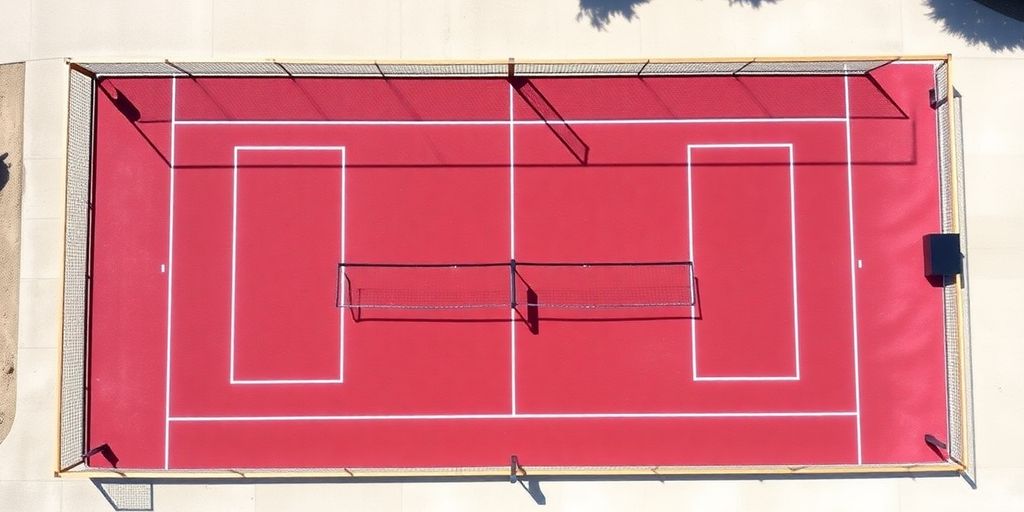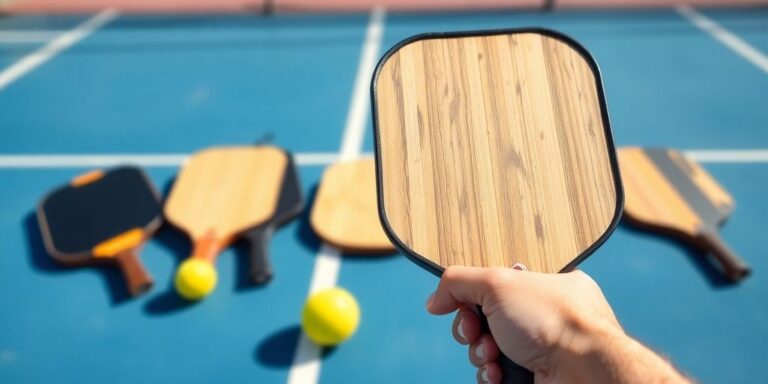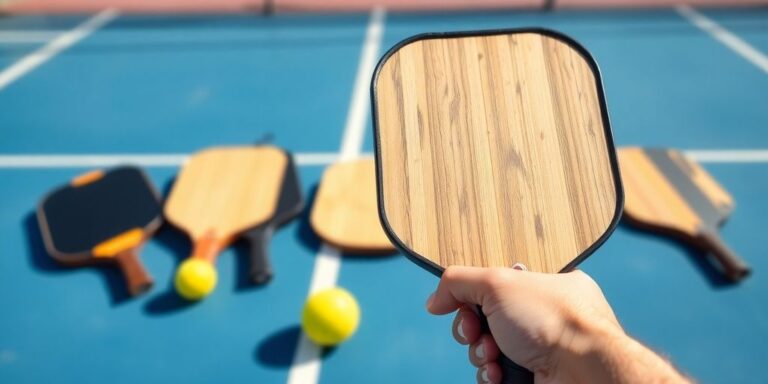So, you’re thinking about setting up a pickleball court, huh? It’s not just about slapping down some lines and calling it a day. There’s a bit more to it, especially if you want to do it right. From the size of the court to the materials you use, each step is important. Whether you’re a newbie to the sport or a seasoned player looking to build your own space, understanding the court’s dimensions is key. Let’s break it down, so you know exactly what you’re getting into.
Key Takeaways
- Pickleball courts are 20 feet wide and 44 feet long, which is the same for singles and doubles play.
- The ‘kitchen’ or non-volley zone is a 7-foot area from the net on both sides of the court.
- Net height is 36 inches at the sidelines and 34 inches in the center, making it slightly lower in the middle.
- When choosing a location for your court, consider sun glare and weather conditions for optimal play.
- Proper court markings are essential for gameplay, including sidelines, baselines, and service areas.
Standard Pickleball Court Dimensions
Understanding the 20 by 44 Feet Layout
A standard pickleball court is a compact, yet well-defined space measuring 20 feet in width and 44 feet in length. This size accommodates both singles and doubles play, offering a versatile platform for various game styles. The court’s dimensions mirror those of a badminton court for doubles, making it easier to adapt existing spaces for pickleball. This layout is perfect for both beginners and seasoned players, providing a balanced mix of strategy and physicality.
The Importance of the Non-Volley Zone
In pickleball, the non-volley zone, often referred to as the "kitchen," is a crucial part of the court. It extends 7 feet from the net on both sides and is marked by a line parallel to the net. Players cannot volley the ball while standing within this zone, which adds a layer of strategy to the game. This rule encourages players to develop precise shot placement and enhances the tactical depth of matches.
Net Height Specifications
The net on a pickleball court is slightly lower than a tennis net, standing at 36 inches tall at the sidelines and dipping to 34 inches at the center. This height is designed to complement the smaller court size and the unique flight of the pickleball, which is lighter and slower than a tennis ball. Setting up a net with these specifications ensures fair play and maintains the intended pace and style of the game. Proper net height is essential for maintaining the integrity of the sport, allowing for a consistent and enjoyable playing experience.
Site Selection and Preparation for Pickleball Courts

Choosing the Optimal Location
Picking the right spot for your pickleball court is the first big step. A flat and level area is ideal to ensure smooth gameplay. Think about the court’s orientation too; a north-south direction helps cut down on sun glare during games. Plus, you’ll want to consider how close the court is to parking and other facilities for convenience.
Considerations for Indoor vs Outdoor Courts
Deciding between an indoor or outdoor court depends on a few factors. Outdoor courts are great for enjoying the weather, but they require more maintenance to handle the elements. Indoor courts offer protection from weather changes, but they can be more expensive to set up. Consider what fits best with your budget and how often you plan to use the court.
Addressing Sun Glare and Weather Conditions
Sun glare can really mess with a game, so it’s important to plan for it. North-south orientation is a good start, but you might also need to think about adding windscreens or shade structures. For weather, make sure there’s proper drainage to avoid puddles after rain, and consider using materials that can withstand different conditions.
Planning your pickleball court’s location and setup carefully ensures a great playing experience, no matter the weather.
Materials and Construction Techniques
Selecting the Right Surface Material
When it comes to building a pickleball court, choosing the right surface material is key. The most common options are asphalt and concrete, each offering unique benefits. Asphalt is generally more affordable and offers a bit more cushioning, which can be easier on the joints. Concrete, on the other hand, is more durable and requires less maintenance over time. Choosing the right material can greatly influence the court’s longevity and playing experience.
Importance of Proper Drainage
Proper drainage is a must for any pickleball court. Without it, water can pool on the surface, leading to slippery conditions and potential damage. A slight slope, typically between 1% and 0.83%, is recommended to guide water off the court. Consider installing a drainage system around the court’s perimeter to keep water from collecting where it shouldn’t.
Fencing and Lighting Considerations
Fencing and lighting are important features that can enhance the safety and usability of your pickleball court. Chain-link fencing is a popular choice because it’s sturdy and allows for good visibility. For lighting, LED options are energy-efficient and provide bright, even illumination, reducing shadows on the court. These features not only improve playability but also extend the hours of use, making it possible to play in the evening or early morning.
Building a pickleball court is more than just laying down a surface; it’s about creating a space that players can enjoy for years to come. With the right materials and construction techniques, you can ensure that your court is both functional and inviting.
Detailed Court Layout and Markings
Marking the Sidelines and Baselines
When it comes to setting up a pickleball court, precision in marking the sidelines and baselines is key. These lines define the boundaries of play and must be clear and accurate. Typically, the court is 20 feet wide and 44 feet long, accommodating both singles and doubles matches. The lines should be 2 inches wide, using durable, contrasting paint or tape to ensure visibility and longevity. Exact measurements are crucial to maintain the integrity of the game.
Defining the Service Areas
The service areas on a pickleball court are split by a centerline into right and left service courts. Each service area measures 10 by 15 feet. Accurate placement of these lines ensures fair play and helps players adhere to the rules. The centerline runs perpendicular to the net and is crucial for defining the service zones, which are essential for starting each rally correctly.
Ensuring Accurate Non-Volley Zone Placement
The non-volley zone, often referred to as the "kitchen," is a critical part of the court. It extends 7 feet from the net on both sides and is marked by a line parallel to the net. This area restricts volleys, adding a strategic element to the game. Properly marking this zone is vital, as it affects gameplay significantly. Players must avoid stepping into this area when hitting a volley, making its accurate placement essential for maintaining fair play.
Understanding the dimensions of a pickleball court is essential for players and enthusiasts. A regulation court measures 44 feet long and 20 feet wide, with a recommended playing area of 64 by 34 feet. Key areas include the non-volley zone, or "kitchen," which extends 7 feet from the net, and service areas measuring 10 by 15 feet. The net spans 22 feet and varies in height, while court lines are 2 inches wide. Facilities often convert tennis courts for pickleball, accommodating multiple courts. Learn more about pickleball court dimensions.
Customization and Additional Features
Incorporating Seating and Shade
Creating a comfortable environment for players and spectators is key. Consider adding benches or bleachers around the court. A shaded area can be a lifesaver on hot days, offering relief from the sun. You might think about installing umbrellas or even a permanent canopy to keep folks cool.
Adding Personal Touches to Your Court
Personalizing your pickleball court can make it feel more like home. Consider painting the court in colors that reflect your personality or team spirit. Some folks even add logos or custom graphics. Don’t forget about the surrounding area—landscaping can add a pleasant touch and enhance the overall vibe.
Considerations for Multi-Court Facilities
If you’re going big with multiple courts, planning is crucial. You’ll need to think about spacing, pathways, and shared facilities like restrooms or changing areas. It’s also wise to consider how you’ll handle lighting and fencing across the larger area. For those looking to maximize space utilization, efficient layout and planning can make all the difference.
When designing your pickleball court, think about the little extras that make the game more enjoyable. Whether it’s a place to sit and relax or a splash of color, these touches can turn a standard court into a personal haven.
Comparative Analysis with Other Sports Courts

Differences Between Pickleball and Tennis Courts
When you compare pickleball courts to tennis courts, the size difference is pretty clear. A standard pickleball court measures 20 feet wide by 44 feet long, while a singles tennis court is a whopping 27 feet wide and 78 feet long. This means tennis courts are designed for more extensive movement and longer rallies. The net in pickleball is lower and stretches 22 feet across, whereas a tennis net is 42 feet across. The smaller size of pickleball courts makes them perfect for quick, agile play, while tennis courts cater to a more endurance-based game.
Comparing Pickleball and Badminton Court Dimensions
Badminton courts are also quite different from pickleball courts. A doubles badminton court is 20 feet wide, just like pickleball, but it’s only 44 feet long. The net’s height is a key difference—badminton nets are 5 feet high, while pickleball nets are just 3 feet at the center. Badminton’s focus is on quick reflexes and precise shots over a shorter distance, which contrasts with the more strategic play in pickleball.
Adapting to Different Court Sizes
Switching between these court types can be challenging. Here are a few tips to help you adapt:
- Understand the dimensions: Knowing the size and layout of the court you’re playing on helps you adjust your strategy.
- Practice different movements: Each sport demands unique movements; practice can make transitions smoother.
- Adjust your mindset: Each court type requires a different approach—pickleball is about precision, while tennis often involves endurance.
"Understanding the nuances of each sport’s court can significantly enhance your gameplay and enjoyment."
When we look at how pickleball courts compare to those used in other sports, it’s clear that each has its own unique features. Understanding these differences can help players improve their game. If you want to dive deeper into the world of pickleball and get expert tips, visit our website today!
Wrapping It Up
So there you have it, the ins and outs of pickleball court dimensions. Whether you’re planning to build your own court or just curious about the setup, knowing these details can really make a difference. From the size of the court to the layout, every bit counts in making sure the game is played right. And hey, if you’re ever in doubt, just remember that a pickleball court is basically the same size as a doubles badminton court. Easy peasy! Now, go grab your paddle and enjoy the game!
Frequently Asked Questions
What is the size of a standard pickleball court?
A standard pickleball court is 20 feet wide and 44 feet long, which is the same for both singles and doubles play.
Can I have a smaller pickleball court in my backyard?
Yes, you can make a smaller court to fit your backyard, but you’ll need to adjust the markings to ensure fair play.
How do I mark the lines on a pickleball court?
To mark the lines, use measuring tape and either paint or tape designed for sports courts to ensure the lines are clear and durable.
What should I think about when designing my own pickleball court?
Consider factors like whether the court will be permanent or temporary, the net height, the type of surface, and making sure all lines are clearly marked.
Is there an easy way to set up temporary pickleball courts?
Yes, you can use cones, chalk, and a measuring tape to quickly set up a temporary court without making permanent changes.
What are the basic materials needed for setting up a pickleball court?
You’ll need measuring tapes, boundary markers, net posts, and nets, along with paint or tape for marking the surface accurately.




